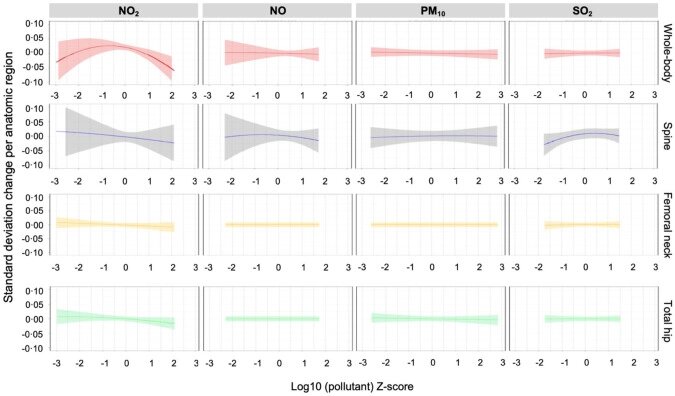
Elevated levels of air pollutants are associated with bone damage among postmenopausal women, according to new research led by scientists at Columbia University Mailman School of Public Health. The effects were most evident on the lumbar spine, with nitrous oxides twice as damaging to the area as in normal aging.
The research findings appear in the journal eClinicalMedicine.
Previous studies on individual pollutants have suggested adverse effects on bone mineral density, osteoporosis risk, and fractures in older individuals. The new study is the first to explore the connection between air pollution and bone mineral density specifically in postmenopausal women, and the first to explore the effects of air pollution mixtures on bone outcomes.
The researchers analyzed data collected through the Women’s Health Initiative study, an ethnically diverse cohort of 161,808 postmenopausal women. They estimated air pollution (PM10, NO, NO2, and SO2) exposures based on participants’ home addresses. They used dual-energy X-ray absorptiometry to measure bone mineral density (BMD; whole-body, total hip, femoral neck, and lumbar spine) at enrollment and at follow-up at year one, year three, and year six.
The magnitude of the effects of nitrogen oxides on lumbar spine BMD would amount to 1.22 percent annual reductions—nearly double the annual effects of age on any of the anatomical sites evaluated. These effects are believed to happen through bone cell death by way of oxidative damage and other mechanisms.
“Our findings confirm that poor air quality may be a risk factor for bone loss, independent of socioeconomic or demographic factors. For the first time, we have evidence that nitrogen oxides, in particular, are a major contributor to bone damage and that the lumbar spine is one of the most susceptible sites of this damage,” says study first author Diddier Prada, MD, Ph.D., associate research scientist in the Department of Environmental Health Sciences at Columbia Mailman School of Public Health.
“Improvements in air pollution exposure, particularly nitrogen oxides, will reduce bone damage in postmenopausal women, prevent bone fractures, and reduce the health cost burden associated with osteoporosis among postmenopausal women. Further efforts should focus on detecting those at higher risk of air pollution-related bone damage,” says lead author Andrea Baccarelli, MD, Ph.D., chair of the Department of Environmental Health Sciences at Columbia Mailman School of Public Health.
Car and truck exhaust is a major source of nitrous oxides, as are the emissions from electrical power generation plants.
Approximately 2.1 million osteoporosis-related bone fractures occur annually, resulting in up to $20.3 billion in annual direct health costs. Osteoporosis impacts women more than men, with 80 percent of the estimated 10 million Americans with osteoporosis being women. Postmenopausal women are at higher risk, with one in two women over 50 experiencing a bone fracture because of osteoporosis.
Previously, Columbia researchers have shown that long-term air pollution exposure reduces BMD and increases bone fracture risk in later life. Subsequently, these findings have been confirmed in multiple human studies. https://medicalxpress.com/news/2023-02-large-air-pollution-bone-loss.html








Recent Comments